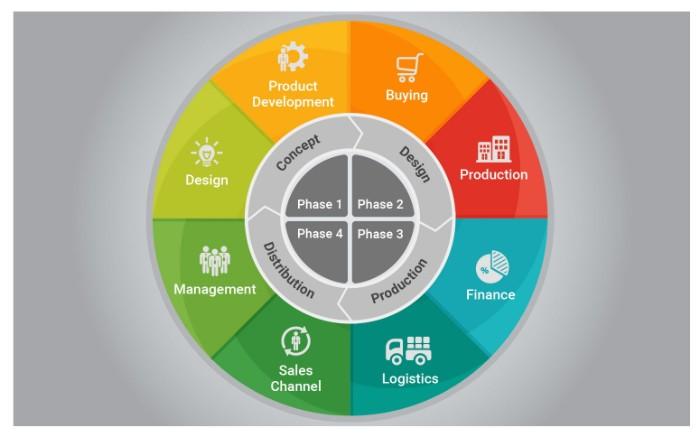Advertisement
What Is Product Lifecycle Management (PLM)?
Dec 24, 2024 By Kelly Walker
Are you looking to streamline your product design, development, and production? Product Lifecycle Management (PLM) could be the answer.
PLM is a technology-driven strategy facilitating communication between departments and stakeholders in product development life cycles.
From ideation through delivery, its goal is to ensure everyone works together efficiently—maximizing the value of new products while managing existing ones more profitably.
In this blog post, we’ll cover what PLM means and how it can benefit your business by enhancing productivity, saving costs, and staying ahead of competitors.
Defining Product Lifecycle Management (PLM).

Productecycle Management (PLM) is an integrated approach to managing all activities related to a product from conception and design to delivery. PLM provides visibility of each step in the product cycle, allowing for stakeholder collaboration.
PLM increases efficiency and reduces costs by streamlining processes and providing real-time access to information throughout the lifecycle.
Benefits of PLM.
Enhanced Productivity
One of the primary advantages of using PLM is increased productivity in product design, development, and production processes. It offers a centralized system where all stakeholders can access real-time data to work together more effectively.
This reduces the need for manual labor and helps teams handle multiple projects simultaneously. PLM also ensures a more consistent product design process by allowing users to take advantage of best practices and templates that can be used across all departments.
Saving Costs
The use of PLM can help businesses save costs in numerous ways. For instance, it allows teams to work more efficiently, leading to fewer errors and waste.
Companies can reduce the time and money needed to develop products by using templates and best practices to streamline processes. Additionally, since PLM helps teams manage existing products more efficiently, they can save money on resources such as inventory or storage costs.
Staying Ahead of Competitors
PLM also helps businesses stay ahead of their competitors by allowing them to develop new products faster and more efficiently. By utilizing a centralized system, teams can quickly access the data and resources they need to deliver quality products promptly.
This helps companies take advantage of market opportunities before their rivals, putting them in a better position to gain customers and increase profits.
Increased Quality
Using PLM can also help businesses improve the quality of their products by allowing them to track product performance more effectively. With real-time data, teams can quickly identify potential problems before they reach the market. This helps ensure that products meet customer expectations and reduces the risk of costly recalls.
Improved Collaboration
PLM also facilitates team collaboration, allowing them to share information quickly and efficiently. By having access to a centralized system, stakeholders can easily collaborate on product development, which helps ensure that all departments are working towards the same goals.
Additionally, PLM makes it easier for teams to communicate with each other and coordinate their efforts, leading to better decisions and faster execution.
Improved Visibility
Finally, PLM can help improve visibility into product performance by providing real-time data on the status of products throughout their lifecycle. This lets stakeholders make more informed decisions about product development and production processes.
Additionally, it enables teams to monitor the progress of projects more effectively, ensuring that they remain on track and meet deadlines.
The components of PLM
Many components of PLM work together to increase efficiency and profitability. These include the following.
Product Development & Design
This component allows companies to manage their design data throughout the entire lifecycle of a product. The goal is to make sure that everyone is working together seamlessly and efficiently with up-to-date information. This can include version control, design collaboration, engineering change orders, and more.
Manufacturing & Engineering
This component focuses on streamlining the production process. It works to maximize operational efficiency while keeping costs low. By integrating CAD/CAM and rapid prototyping, companies can reduce time-to-market and improve quality control.
Manufacturing & Supply Chain
This component optimizes supply chain processes such as procurement, inventory management, and logistics. This helps ensure the timely delivery of products while minimizing costs related to warehousing and transportation. By tracking demand trends, PLM can also help anticipate customer needs and plan for future growth.
Product Lifecycle Support
This component enables companies to better manage product support activities like technical inquiries and customer feedback. It works to keep customers informed about new products and services while helping ensure that the products are of high quality. Additionally, it can help manage product returns and warranties.
How PLM fits into a Company’s Business Strategy.

Product Lifecycle Management (PLM) solutions can be a powerful tool in helping companies reach their objectives. PLMs provide a single source of truth and collaboration platform that helps stakeholders throughout the product development lifecycle, from ideation to delivery.
This feature of unifying departments and streamlining processes benefits an organization's overall business strategy. PLMs ensure that all departments work together efficiently, improving communication and collaboration to create better products faster and at a lower cost.
Furthermore, the data collected by PLM solutions can provide valuable insights into customer behavior, allowing companies to stay competitive in their respective markets. As such, businesses should consider using a comprehensive PLM system to stay ahead of the competition and maximize their profits.
Understanding the Different Stages of the Product Lifecycle.
The product lifecycle is a process that outlines the different stages of new and existing products, from development to retirement. It begins with research and design, production, distribution, sales and use, support, and eventual disposal.
PLM (Product Lifecycle Management) is an effective strategy for managing the entire product lifecycle, allowing companies to track and optimize each stage. This helps businesses stay ahead of the competition by quickly identifying improvement opportunities, helping them reduce costs and maximize profits.
PLM provides a unified platform for all departments to collaborate efficiently, increase transparency, and share information seamlessly. By leveraging technology, PLM simplifies the entire process from product development to delivery, allowing companies to save time, reduce errors and deliver products to market faster.
Ultimately, PLM helps businesses stay competitive in today's fast-paced digital age. And that's the power of Product Lifecycle Management!
Tips for success when implementing PLM in your organization.
- Leverage your existing investments in Enterprise Resource Planning (ERP) systems. PLM solutions can be integrated with ERP and other enterprise applications to provide a more holistic product lifecycle view.
- Invest in configurable software to allow for flexibility as product development needs change. This will help you avoid costly upgrades or the need to replace your PLM solution in the future.
- Choose a Partner with deep expertise and experience in product lifecycle management who can provide support throughout the implementation process.
- Ensure that the system is user-friendly and easy to learn; encourage adoption among employees by training them on how to use the new system.
- Monitor progress and KPIs to ensure the system delivers the expected business outcomes.
FAQs
What is the PLM product management lifecycle?
The product management lifecycle, or simply the PLM cycle, is an iterative process that begins with identifying customer needs and continues through conception, design, development, production, and delivery.
What is the goal of PLM?
PLM aims to help organizations streamline their product design, development, and production processes. It facilitates communication between departments and stakeholders in the product development lifecycle to maximize the value of new products while managing existing ones more profitably.
What is an example of product lifecycle management?
An example of PLM is a tool that provides easy access to product information and tracks the progress of projects at various stages in the development process. This helps teams keep track of tasks, manage customer feedback, and optimize processes.
Conclusion
A successful business strategy requires using Product Lifecycle Management (PLM). PLM provides a framework for companies to streamline the design and development of production processes.
Furthermore, it can ensure that products remain competitive while increasing revenues. Through understanding and applying the components of PLM, companies can benefit from improved information accuracy and visibility, increased efficiency and productivity, and better customer experience.
Advertisement

10 Steps to Becoming a Day Trader

10 Largest Software Companies

Everything You Should Know About Mechanical Investing

Best Online Bookkeeping Classes

Which Is Better, Coinsurance or Copays?

SIMPLE IRA Vs. Traditional IRA: What’s the Difference?

Demystifying IPO Investments: How to Buy Your First IPO Stock

Best Call Center Services for 2023.

How much to save in your 20s, 30s, 40s and beyond

